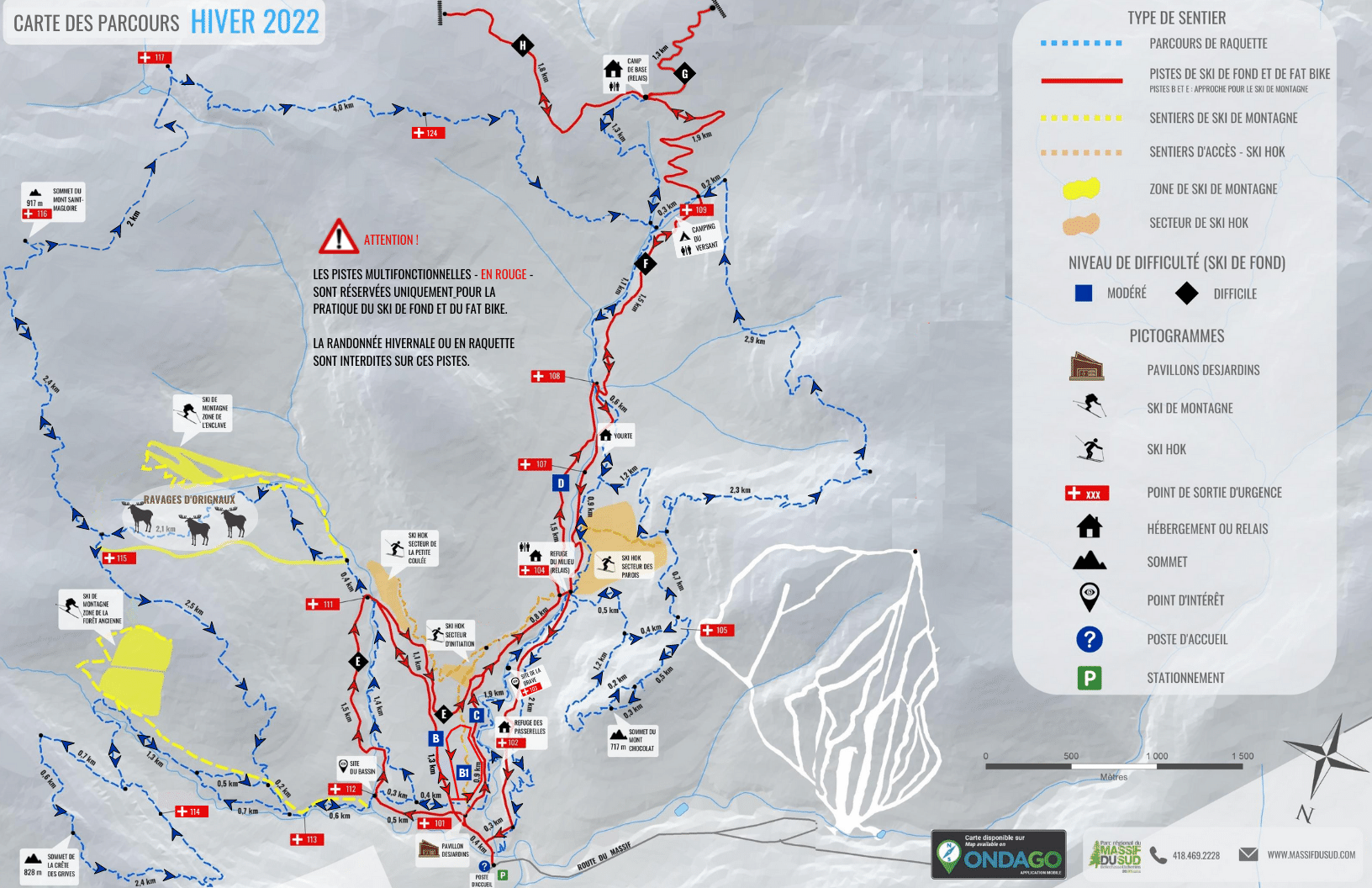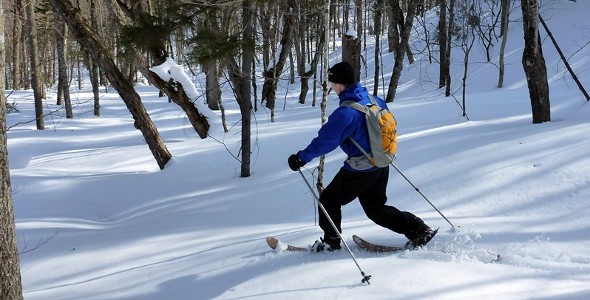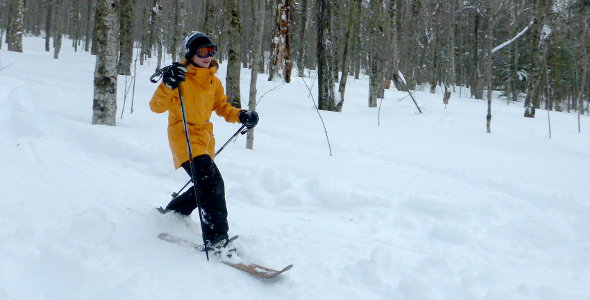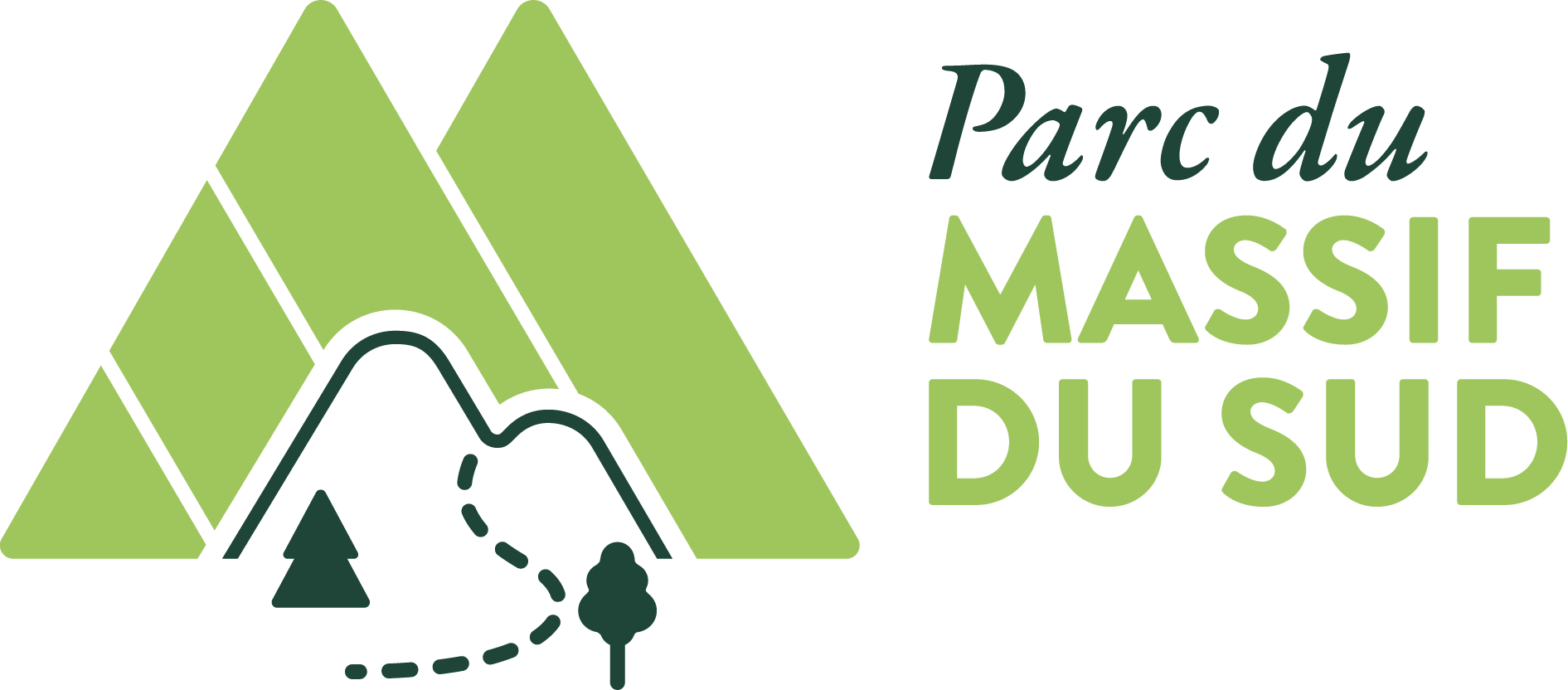Home » Activities » Skishoeing (Hok skiing)
Gaining in popularity, skishoeing, also known as Hok skiing, with its shorter length and greater width skis, is a hybrid between snowshoeing and backcountry skiing. The skis were designed to make journeys in deep snow easier and faster, with less effort than with traditional snowshoes. A synthetic climbing skin was integrated to the ski for smooth ascents but still allowing the user to have fun on the way down. In really deep snow, it is like floating on a cloud!
- Faster than snowshoeing off-trail;
- Universal bindings suitable for all kind of hiking and winter boots;
- Synthetic skin under the ski to allow for easier movements on flat surface and uphill but still allowing for a nice glide on the way down;
Skishoeing is an activity that will please beginners just as much as more experienced skiers.
***Dogs are not allowed for safety reasons.
Massif du Sud regional park is a prime destination for skishoeing with its cleared maple forests, hilly terrain and exceptional snowfall. Three areas were developed in the park for skishoeing only, giving you the chance to go off-trail in the forest and to enjoy a few nice runs down the snowy hills.
SAFETY GUIDELINES AND USEFUL TIPS FOR SKISHOEING
BEFORE YOU LEAVE
- Check your equipment and/or make sure you understand the use of the rented equipment
- Choose synthetic clothing rather than cotton, they will dry faster and keep you warm even if they are wet
- Bring spare clothing, such as socks, mitts and hats
- Wear or bring goggles to avoid eye injuries in the undergrowth zones
- Bring enough water (1 litre minimum) and a snack
- Bring a small backpack with a headlamp, matches, sunscreen lotion, a first aid kit and a map of the skishoeing zones
- Plan your itinerary on a map and let someone know of your plan, including departure and return time
- Choose a zone that fits your capacities, taking into account the reduced sunshine duration during winter, the time you have, the distance of the zone from the visitor center and the vertical drop
- Check the weather forecast before leaving
- Warm-up and stretch to reduce risks of injuries
WHILE SKIING
- For your own safety, never leave alone
- Be aware that skishoeing is practiced in unpatrolled undergrowth areas that are not cleared of branches (some are protected areas); don’t take unnecessary risks
- Always stay within the signaled zones and use the marked trail to go uphill
- Be aware of and respect the opening hours of each zone
- Don’t wear the straps of your poles around your wrists. That way, if you fall or your poles get stuck, you will reduce your risks of injuries
- Control your speed at all times
- Drink water often and in small quantities
- Carry your trash with you to dispose of it in a garbage bin
- Don’t hesitate to evaluate your itinerary during the day and to turn around if necessary
What to do in a blizzard?
A blizzard is a sudden snow and wind storm causing snow to be blown around and reducing visibility. This phenomenon is common in high altitude areas where the vegetation is rarer and the mountains more exposed
If you get caught in a blizzard or in blowing snow, here are a few tips to help you:
- Protect your face and exposed skin by covering it with clothing (sunglasses, scarf, neck warmer, etc.)
- Protect yourself from the wind in a sheltered wooded area or in a mountain hut, if one can be found near you. Avoid leaving the trail
- Turn around and make your way down to the visitor center as soon as possible
What to do if you are injured and cannot move?
- First, if you have a cellphone with you, see if you have cellphone signal where you are. If so, call the visitor center at 418-469-2228 extension 101. Explain your situation and ask for help
- If you don’t have cellphone signal where you are, but you’re not alone, protect yourself from the cold, the wind and the ground. Once you are in a stable position, ask your partner to go get help at the visitor center
- If you are by yourself, cannot move and don’t have cellphone signal, try to stay as warm as possible and protect yourself from the ground with some form of insulation. Stay close to the trail and try to be easy to see by other users or the rescue team
In any case, never leave the signaled areas
What to do if you are lost?
- If you left the signaled area and you don’t know where you are, turn back following your tracks until you reach the signaled area
- If you cannot see your tracks, and are on a slope, slowly make you way down: most of our trails follow rivers or streams in the valleys. If you reach a river or a stream, follow it until you reach a trail
- If you cannot see your tracks, and even by going down into the valley you cannot find any stream, river or trail, but you have a cellphone, see if you have cellphone signal where you are. If so, call the visitor center at 418-469-2228 extension 101. Explain your situation and ask for help
- If you don’t have cellphone signal where you are, you cannot see your tracks and are lost outside of the signaled area, try to orientate yourself: try to find a summit or another clue to where you might be. Move only if you are sure of the direction you’re heading to
- Otherwise, the best thing to do is to stay where you are, to protect yourself as much as possible from the elements, to make sure you are easy to see using any colorful object (clothing, tent, tarp, etc.) and, if you have one, by using your whistle, or calling for help. If night falls, turn a headlamp on or start a fire to ensure you are easy to spot
In any case, it is preferable to wait for help rather than spending your energy going around in circles in the woods

Trail map |
See trail map |
Guided introduction to skishoeing
Not quite ready to face this new discipline on your own? Join our guide to get a better undestanding of the sport! Massif du Sud regional park offers a 3-hour crash course on skishoeing, allowing you to get familiar with the equipment and the techniques to get up and down the hills!
Level : Easy/Beginner
Minimum age of participants : 9 years old
Where : Massif du Sud regional park (visitor center)
Average time: 3 hours, including explanations and approach
Elevation gain : 100 m
Equiment included : Skishoes and poles (you can bring your own poles if you prefer)
Price : 25,00 $ per person, equipment included
What to bring : Winter boots (with a good hold of your foot and ankle), ski goggles, clothing according to the day’s weather forecast, water bottle, whistle.
Dates : Check the calendar for the dates. If you are a group of 4 people or more and would like to have an introduction at another time, contact us at 418-469-2228 extension 101 to make arrangements.
Massif du Sud regional park reserves the rights to cancel the activity described above if the snow conditions are unsuitable. In that case, the park will contact you the day before the activity to change or refund your reservation.
Guided skishoeing adventure – 2 days/1 night
Massif du Sud regional park is happy to partner up with Quatre Natures, to offer you a 2 days skishoeing excursion! This all-inclusive adventure will give you the chance to discover the park differently while working on your skishoeing techniques. Meet your guide at the visitor center of Massif du Sud regional park, where he will take care of everything, from teaching you the basics of skishoeing, to cooking dinner and even making sure your luggage gets to the cabin for your night in the park.
The perfect opportunity to forget about everything else and focus on having fun while safely working on your techniques!
Visit Quatres Nature‘s website to learn more about this activity or to sign up.












